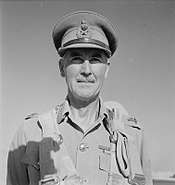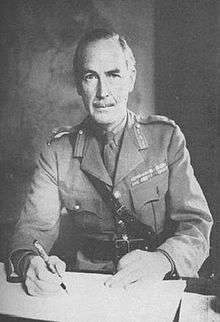Alan Cunningham
| Sir Alan Cunningham | |
|---|---|
 | |
| Born |
1 May 1887 Dublin, Ireland |
| Died |
30 January 1983 (aged 95) Tunbridge Wells, Kent, England |
| Buried | Dean Cemetery, Edinburgh, Scotland |
| Allegiance |
|
| Service/ |
|
| Years of service | 1906–1946 |
| Rank | General |
| Service number | 74 |
| Unit | Royal Artillery |
| Commands held |
Eastern Command Northern Ireland Staff College, Camberley Eighth Army East Africa Force 51st (Highland) Infantry Division 9th (Highland) Infantry Division 66th Infantry Division 5th Anti-Aircraft Division |
| Battles/wars |
World War I World War II Palestine Emergency |
| Awards |
Knight Grand Cross of the Order of St Michael and St George Knight Commander of the Order of the Bath Distinguished Service Order Military Cross Mentioned in despatches (4) |
| Relations | Andrew Cunningham, 1st Viscount Cunningham of Hyndhope (brother) |
| Other work |
High Commissioner of Palestine (1945–48) Colonel Commandant of the Royal Artillery |
General Sir Alan Gordon Cunningham GCMG, KCB, DSO, MC (1 May 1887 – 30 January 1983) was a senior officer of the British Army noted for his victories over Italian forces in the East African Campaign during World War II. Later he served as the seventh and last High Commissioner of Palestine. He was the younger brother of Admiral of the Fleet Lord Cunningham of Hyndhope.
Early life and military career
Cunningham was born in Dublin, Ireland, the third son of Scottish Professor Daniel John Cunningham and his wife Elizabeth Cumming Browne.[1] He was educated at Cheltenham College and the Royal Military Academy, Woolwich before taking a commission in the Royal Artillery in 1906.[2] During the First World War, he served with the Royal Horse Artillery, and was awarded a Military Cross in 1915 and the Distinguished Service Order in 1918. For two years after the war he served as a staff officer in the Straits Settlements.[2]
After graduating from the Royal Naval College, Greenwich in 1925, followed by the Imperial Defence Studies in 1937, Cunningham became the Commander, Royal Artillery of the 1st Infantry Division.[2] This was followed in 1938 by promotion to major general and appointment as commander of the 5th Anti-Aircraft Division.[2]
Second World War

After the beginning of Second World War, Cunningham held a number of short appointments commanding infantry divisions in the United Kingdom (66th Infantry Division, 9th (Highland) Infantry Division, and following its renaming, the 51st (Highland) Infantry Division)[2] before being promoted to lieutenant-general to take command of the East Africa Force in Kenya.[2]
During the East African Campaign General Sir Archibald Wavell, the Commander-in-Chief of the British Middle East Command, directed Cunningham to retake British Somaliland and free Addis Ababa, Ethiopia from the Italians whilst forces under the command of Lieutenant-General Sir William Platt would attack from Sudan in the north through Eritrea. Cunningham's offensive started with the occupation of the Indian Ocean ports of Kismayu (Italian: Chisimaio) and Mogadishu (Italian: Mogadiscio), the Italians having fled into the interior of Somalia. On 6 April 1941, Cunningham's forces entered Addis Ababa. On 11 May the northernmost units of Cunningham's forces, under South African Brigadier Dan Pienaar linked with Platt's forces under Major-General Mosley Mayne to besiege Amba Alagi. On 20 May, Mayne took the surrender of the Italian Army, led by Amedeo di Savoia, 3rd Duke of Aosta, at Amba Alagi.
Cunningham's campaign was a swift action which resulted in the taking of 50,000 prisoners and the loss of only 500 of his men.
His success in East Africa led to Cunningham's appointment to command the newly formed Eighth Army in North Africa in August 1941.[2] His immediate task was to lead General Sir Claude Auchinleck's Libyan Desert offensive which began on 18 November. However, early losses led Cunningham to recommend the offensive be curtailed. This advice was not accepted by his superiors, and Auchinleck relieved him of his command.[2] He returned to Britain to serve the remainder of the war as Commandant of the Staff College, Camberley (1942) and General Officer C-in-C in Northern Ireland (1943) and Eastern Command (1944).[2] He was knighted in 1941.
Post-war
After the war, Cunningham, who was promoted to general on 30 October 1945, returned to the Middle East as High Commissioner of Palestine; he served in the position from 1945 to 1948.[2] As such, he was in charge of the confrontation with Hagana, Etzel and Lehi who in this period challenged its rule in Palestine.
Cunningham had retired from the army in October 1946 when he relinquished the role of Commander-in-Chief Palestine, but retained the job of High Commissioner until 1948.[2] As such he had the task of winding up British rule and departing the country in May 1948, with the British mandate expired, in the midst of war between Jewish forces and Palestinian militias, with Arab armies poised to invade as soon as the British withdrew. The photo of Cunningham taking down the British flag at the port of Haifa is a historical photo often reproduced in Israeli history textbooks.
Cunningham served as Colonel Commandant of the Royal Artillery until 1954.[3] Cunningham died in Royal Tunbridge Wells, Kent, England. He is buried with his father and mother under a very simple monument near the Dean Gallery entrance to Dean Cemetery in Edinburgh.
Orders and decorations
(This list is incomplete.)
- Knight Grand Cross of the Order of St Michael and St George (1948)[4]
- Knight Commander of the Order of the Bath (30 May 1941; Companion 1941)[4]
- Distinguished Service Order (1918)[4]
- Military Cross (1915)[4]
- 1914 Star with Clasp[4]
- Mentioned in Despatches (1 January 1916, 18 May 1917 and 20 May 1918; 6 January 1944)[4]
- British War Medal[4]
- Victory Medal[4]
- Order of the Brilliant Star of Zanzibar, 1st class (28 October 1941)[4]
- Commander of the Legion of Merit (United States, 1945)[4]
- Order of the Crown, 1st class (Belgium, 1950)[4]
- Order of Menelik II, 1st class (Ethiopia, 1954)[4]
References
- Houterman, Hans; Koppes, Jeroen. "World War II unit histories and officers". Archived from the original on 24 July 2008. Retrieved 12 June 2008.
- Mead, Richard (2007). Churchill's Lions: A Biographical Guide to the Key British Generals of World War II. Stroud, UK: Spellmount Limited. pp. 543 pages. ISBN 978-1-86227-431-0.
- ↑ "D Cunningham Household Census Return, 1901". Retrieved 18 March 2011.
- 1 2 3 4 5 6 7 8 9 10 11 Liddell Hart Centre for Military Archives
- ↑ Houterman & Koppes
- 1 2 3 4 5 6 7 8 9 10 11 12 Houterman, Hans; Koppes, Jeroen. "British Army Officers 1939–1945 (COAT to CUTT)". World War II unit histories and officers. Retrieved 27 August 2014.
External links
| Military offices | ||
|---|---|---|
| Preceded by New post |
GOC 5th Anti-Aircraft Division 1938–1940 |
Succeeded by Robert Allen |
| Preceded by Arthur Purser |
GOC 66th Infantry Division January–June 1940 |
Succeeded by Post disbanded |
| Preceded by Edward Beck |
GOC 9th (Highland) Infantry Division June–August 1940 |
Succeeded by Post redesignated 51st (Highland) Infantry Division |
| Preceded by New post |
GOC 51st (Highland) Infantry Division August–October 1940 |
Succeeded by Neil Ritchie |
| Preceded by Douglas Dickinson |
GOC East Africa Force 1940–1941 |
Succeeded by Harry Wetherall |
| Preceded by New post |
GOC Eighth Army September–November 1941 |
Succeeded by Neil Ritchie |
| Preceded by Montagu Stopford |
Commandant of the Staff College, Camberley 1942–1943 |
Succeeded by Douglas Wimberley |
| Preceded by Vivian Majendie |
GOC British Army in Northern Ireland 1943–1944 |
Succeeded by Gerard Bucknall |
| Preceded by Sir Kenneth Anderson |
GOC-in-C Eastern Command 1944–1945 |
Succeeded by Sir Oliver Leese |
| Government offices | ||
| Preceded by John Vereker, 6th Viscount Gort |
High Commissioner of Palestine 21 November 1945–14 May 1948 |
Succeeded by Chaim Weizmann (First President of Israel) David Ben-Gurion (First Prime Minister of Israel) |